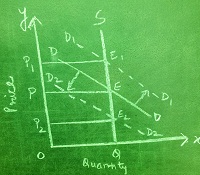Equilibrium price is determined by the industry at
that point where total demand is equal to total supply.
But, whether demand
will have more effect or supply on the determination of the price, will depend
on how much time will it take for
the demand and supply to stabilize.
Importance of
time element in the determination of price has been first examined by Dr. Marshall.
According to him, shorter
the time period, greater will be the influence of demand in price determination
and longer the period, greater will be the influence of supply on prices.
Marshall has divided the time elements into four
periods:
1) Very short
period or market period
2) Short
period
3) Long
period
4) Very long
period
Very short period or market period
It is the time
period during which supply of a commodity can be increased only up to the
extent of its existing stock.
In case of
perishable commodity which cannot be stored, supply becomes absolutely fixed or perfectly inelastic.
This is so because
very short period is too short to increase production either through the
application of fixed factors or the variable factors, all factors are rendered
to be fixed during the very short period.
In such a situation
demand plays a major role in the
determination of price as supply is inelastic
(fixed).
For example, when
the farmer brings his perishable vegetables to the market, the quantity is
fixed, now price will be high or low depending upon the demand for the
vegetables.
The price that
prevails in very short period is called market
price.
As shown by the
graph below:
 |
| Equilibrium Price |
X axis shows a
perishable commodity and price on Y axis. Supply curve is perfectly inelastic,
parallel to Y axis, which signifies that supply is fixed in very short period.
OP is the initial market price with the intersection of the demand curve (DD)
and supply curve.
If the demand
increases in very short period, as shown by the demand curve D1D1,
then equilibrium price rises to OP1, quantity remains the same OQ.
If the demand decreases in very short period,
as shown by the demand curve D2D2, then equilibrium price
falls to OP2, quantity remains the same OQ.
Short
period
Short period is the period of time during which
production can be increased only through the application of variable factors,
fixed factors(new machine, plants, entry of new firms) continue to be constant
simply because time is too short to change them.
So supply assumes flexibility but cannot fully
adjust itself to changes in demand.
Graphically (as shown below), the short run supply
curve is more elastic than the very
short period supply curve.
 |
| equilibrium price |
SR is
the short run supply curve, with initial price and quantity be OP and OQ
respectively.
In short run period
supply can be increased by changing variable factors, so rise in the price is
low as compared to in very short period(as supply was fixed).
Price rises to P1
and quantity to Q1. New equilibrium is E1.
The price which
prevails in short period is Sub- normal
price.
Long
period
It is the period of time when supply can fully
adjust itself to changes in demand.
Long period is long enough to enable existing firms
to change their scale of production, new firms to enter.
The price which
prevails in long period is normal price.
Long run supply
curve is relatively more elastic than the short run supply curve.
As shown in the
graph above. SL is the
long run supply curve. Supply plays more important role in price determination
in the long run.
The long run equilibrium
is given by the point E2 , with the intersection of D1D1
with SL. The long run equilibrium price and quantity is OP2
and OQ2 respectively.
In the long run quantity changes will be more and price changes will be less for a given
change in demand than in case of the market period or short period.
Very
long period
Very long period
refers to the time period in which full adjustment can be done in both demand
and supply.
Demand and supply can adjust to changes in all the factors
affecting demand and supply.
Very long period
price is called secular price.

No comments:
Post a Comment